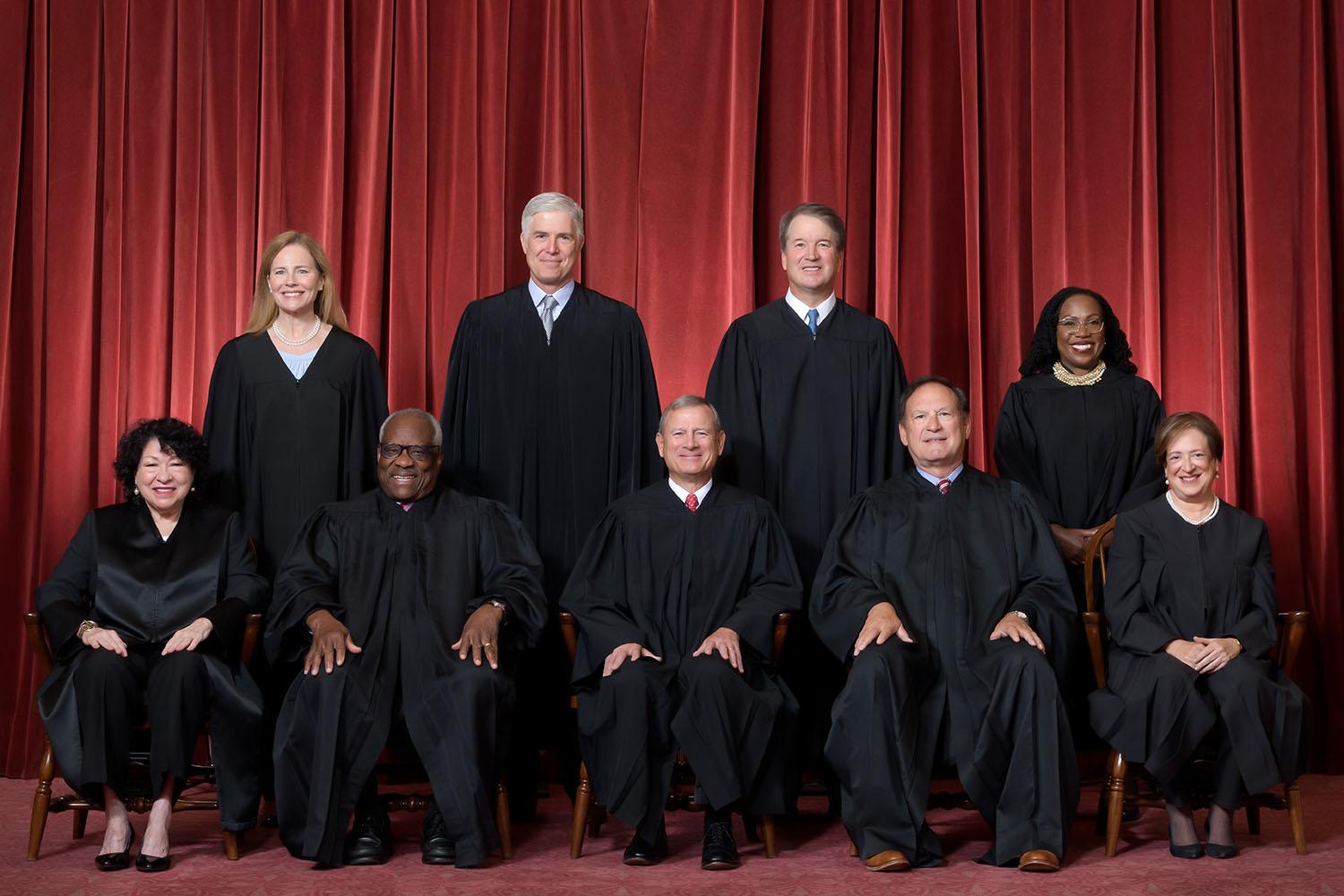
Seated from left are Justices Sonia Sotomayor, Clarence Thomas, Chief Justice John G. Roberts, Jr., and Justices Samuel A. Alito and Elena Kagan.
Standing from left are Justices Amy Coney Barrett, Neil M. Gorsuch, Brett M. Kavanaugh, and Ketanji Brown Jackson.
Credit: Fred Schilling, Collection of the Supreme Court of the United States
The U.S. Supreme Court issued a much-anticipated ruling yesterday that may open the door for Guam’s victims of clergy abuse with claims against the Boy Scouts to be paid significantly more in settlement.
In a 5-4 ruling with an unusual split mixing the conservative and liberal justices, the court held that the bankruptcy court in the Purdua Pharma opioid settlement could not immunize the Sackler family, its owners, from future liability since the family was not party to the bankruptcy.
As reported by the Los Angeles Times, Justice Neil Gorsuch, writing for the majority, wrote “We hold only that the bankruptcy code does not authorize a release and injunction that, as part of a plan of reorganization under Chapter 11, effectively seeks to discharge claims against a nondebtor without the consent of affected claimants.”
This ruling has been what Guam attorney Delia Lujan Wolff has been anticipating for her clients in the local clergy abuse case who account for the vast majority of the nearly 300 who filed claims against the Archdiocese of Agana. While the case against the Archdiocese has been settled, most of the claimants named another defendant: Boy Scouts of America.
More than 100,000 organizations throughout the country have liability linked to the Boy Scouts of America’s alleged cover up of clergy and BSA sex abuse.
Ms. Wolff waged a national battle for her clients after a bankruptcy court settled the several cases against the BSA in one nationwide case and released the linked organizations from liability. Those organizations are believed to have billions in combined assets above the BSA. Her fight included court losses at the circuit level before Justice Samuel Alito granted Ms. Wolff’s motion to stay the bankruptcy case pending the Supreme Court’s resolution of the matter.
Bankruptcy professionals throughout the country have been monitoring both cases. The Purdue case and the Lujan case (reference made to Ms. Wolff and her father who began Guam’s historic litigation against clergy sex abuse and cover up – attorney David Lujan) are strikingly similar. Both cases propose that bankruptcy courts have no authority under federal bankruptcy laws to declare parties not involved in a given bankruptcy case immune from liability to the bankruptcy applicant’s (called a debtor) creditors, according to both cases. And while the Supreme Court eventually declined to take on the Lujan case on appeal, the Purdue case remained on its docket.
As the Guam claimants’ cases had been moving forward, other cases throughout the country also went through their respective jurisdictions’ courts. That is, until the BSA filed for bankruptcy in Delaware in February 2020. At that time, Guam’s 75 claimants accounted for one quarter of all claims nationally. Then, by the bar date for claims, the total rose to more than 82,000.
The Delaware court approved a settlement plan in September 2022 to pay the 82,000 claimants from BSA assets and release 250 local Boy Scouts councils and more than 100,000 organizations that have been included in BSA co-insurance policies since 1976. These include insurance companies, American Legion chapters, police departments, and churches associated with the Boy Scouts chapters. None of these organizations were party to the bankruptcy, yet received the protections of bankruptcy in the BSA bankruptcy case. Ms. Wolff and her clients immediately objected to the settlement and for two years litigated in Delaware and then on appeal to the Third Circuit. Both courts denied Ms. Wolff’s applications for stays.
In the midst of the court battle, the Purdue settlement case reached the U.S. Supreme Court, and Ms. Wolff pointed to it and its striking similarity to the questions she has raised on appeal. On April 19 last year, Ms. Wolff’s application for stay was denied by the Third Circuit, and one hour later, BSA began to implement the settlement plan.
With the start of its implementation, nearly all hope was lost that any of the 82,000 claimants against BSA would be able to receive compensation from more than 100,000 entities with billions in combined assets. And then Mr. Alito did what is believed to be unprecedented: he stayed the further implementation of the settlement plan already in motion, with court observers believing the stay has everything to do with a decision by the Supreme Court expected any day now on the Purdue Pharma bankruptcy settlement case.
Just like the BSA case, the bankruptcy court in Purdue released nonmoving debtors from liability to pay the victim claimants of the opioid crisis Purdue is accused of creating throughout the country through its marketing of its highly addictive narcotic Oxycontin. Among those nonmoving debtors was Purdue’s owners, members of the multibillionaire Sackler family. The Sacklers did not file bankruptcy, and so their assets were never discovered for the purposes of the Purdue bankruptcy case, yet that bankruptcy court approved a settlement plan where the Sackler family would pay $6 billion over a 1o year period and be released from any further lawsuit on the matter. The victim claimants did not agree to that, as the particular bankruptcy case to determine that settlement was against Purdue, not the Sacklers.
The Biden Justice Department’s U.S. Trustee in the Purdue case raised objections to the Purdue settlement, which paved the way for December 2023 arguments before the U.S. Supreme Court. Several reports about that day state the Justices had questions that were far ranging and outside the scope of the appeal. The question in that case is the same question Lujan raised:
“Whether the Bankruptcy Code authorizes a court to approve, as part of a plan of reorganization under Chapter 11 of the Bankruptcy Code, a release that extinguishes claims held by nondebtors against nondebtor third parties, without the claimants’ consent.” (In re Purdue Pharma LP et al., Case Number 22-110 (2nd Cir. 2023)
The significant difference is that unlike the Purdue settlement, BSA already began making distributions according to the settlement plan. The mid-execution of the plan normally would have rendered the question moot, according to several law firms throughout the nation that have published reports about the February 16, 2024 stay by Mr. Alito. The fact that the high court did not reject the Lujan case question in BSA is itself unique, with the eyes of corporate America glued to both cases.
While the Purdue decision might be cause for celebration for Ms. Wolff’s clients, it will mean a painful path for victims of the Purdue opioid settlement, who were anticipating a $10 billion payout of which $6 billion voluntarily came from the Sackler family in exchange for their immunity from future claims on the matter.
The Los Angeles Times reported that Justice Brett Kavanaugh wrote in the dissent: “Today’s decision is wrong on the law and devastating for more than 100,000 opioid victims and their families. The court’s decision rewrites the text of the U.S. Bankruptcy Code and restricts the long-established authority of bankruptcy courts to fashion fair and equitable relief for mass-tort victims. As a result, opioid victims are now deprived of the substantial monetary recovery that they long fought for and finally secured after years of litigation.”



